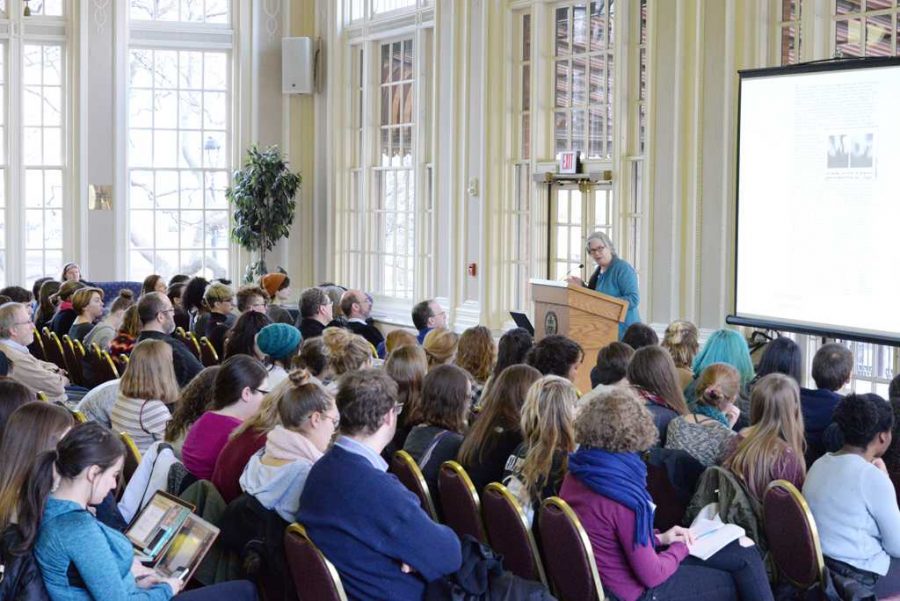With a discussion on sex and anatomy, Susan Wells documented the history of female empowerment in a lecture this weekend.
On Friday, Feb. 5, about 75 students, graduates and faculty members gathered in the lower lounge of the William Pitt Union to hear Wells’ “In Search of the Clitoris.” Wells, a professor at Temple University and author who focuses on critical theory and feminism, aimed to inform students about the history of the female sex organ and how it has influenced modern feminism.
The talk was part of the Agora Speaker Series, a yearlong lecture circuit Pitt’s communication department sponsors. The series features new speakers every two weeks from 3 to 5 p.m. The talks began Sept. 11, and will continue through April 8. Topics range from race, education and opportunity to China and the global Internet.
Audience members filled rows of seats and spread to couches and armchairs around the edges of the room. With drawings of early interpretations of the clitoris and informational pamphlets from the ’70s, Wells took the audience through a history of the sexual organ.
In her lecture, Wells explained that the women’s movement in the ’60s and ’70s had prompted women to know their bodies and be open about their sexuality, shaping a discussion of female anatomy.
“The anatomy of the body as a whole was organized around the male body. The male was the norm, and any difference was seen as a deviation,” Wells said.
Wells started her research by looking at a group of 12 women in Boston in 1969.
The women, titled the Boston Women’s Health Book Collective, published pamphlets from 1971 to 2011 detailing information about sex, female anatomy and abortion, among other controversial topics.
“I learned that the Boston Women’s Health Book Collective papers, all 400 boxes of them, had been donated to the Schlesinger Library,” Wells said. “So I set about working with the papers and interviewing members of the collective.”
More so than just understanding the anatomy, the collective’s work examined women and sexual pleasure in a new way. Women were encouraged to explore their bodies and feelings.
“Only recently, as more and more physicians have had a keener sense of gender equity, have there been systematic efforts to think about the variety of ways in which human bodies work,” Wells said.
This shift within the medical community was an important issue to the collective. They spent years going through medical journals in order to become informed about issues with the body, and then encouraged women to go to the doctor with knowledge of their own anatomy.
Sandra Nelson, a Ph.D. student with a certificate in gender, sexuality and women’s studies who attended the event, said that the scientific and anatomical understanding of the clitoris helps make the feminist argument more sound.
“It kind of takes feminism, which is sometimes discounted unfairly due to its associations with the communities, and gives it more academic credibility,” Nelson said.
Navigating the modern day medical system challenged women in the ’70s and ’80s, but as the collective shared more information and experiences, women’s ability to talk openly with their physicians became easier, according to Wells.
For Todd Reeser, director of the GSWS department, the lecture added a new element to the conversation about sexuality.
“American culture has much to say — directly and indirectly — about the corporality of male sexuality, so this addition to the discussion was most welcome,” Reeser said.
As the collective encouraged more women to be comfortable and familiar with their bodies, the treatment within the medical system changed over time.
“Such an understanding is basic survival equipment for women who need to navigate contemporary medical care,” Wells said. “But it is also an important part of self-awareness, and a great weapon against self-consciousness.”
The women of the collective worked hard to battle self-consciousness within their gender, encouraging familiarity with and discussion of women’s bodies.
“I think that it is still vitally important for women — for people of every gender — to feel free to explore their bodies, to understand the medical explanations for how bodies work and to talk to others about their experiences,” Wells said.


